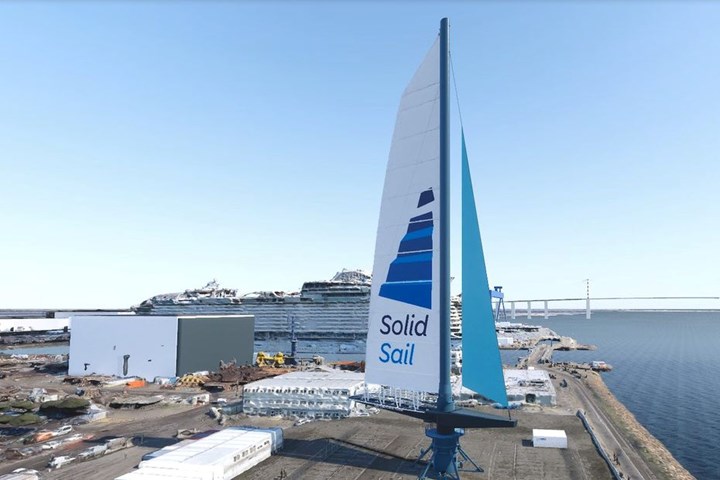Chantiers de l’Atlantique reveals 66-meter, all-composite SolidSail mast
A technological feat, the large carbon fiber mast prototype targets the Silenseas sailing liner and sailing cargo ships for up to 40% reduction in CO2 emissions.
Share
Read Next
Three years ago, Chantiers de l’Atlantique, a shipbuilder in Saint-Nazaire, France, brought together composites industry and offshore racing experts — Lorima, Multiplast, Avel Robotics, CDK Technologies and SMM — for the construction of its first large carbon fiber mast. Recently, the shipyard unveiled the full-scale mast prototype for its SolidSail project, which was assembled and revealed in Lanester, France.
SolidSail is an efficient, 100% composite foldable sail. The mast, 66 meters high, 2 meters wide and weighing 20 tonnes, was assembled in less than six months. Reported to be one of the tallest and strongest masts in the world, it is able to accommodate a 1,500-square-meter sail without guying (braces or cables fastened to the pole to strengthen it and keep it in position). The Aeoldrive rig, which includes the SolidSail mast and sail, is fully automated; its balestron can be rotated 360º and the masts can rotate or tilt 70º to pass under decks.
The SolidSail project is designed for the Silenseas, one of the largest future sailing liners in the world, as well as sailing cargo ships and mid-sized cruise ships. The eventual goal is to reduce greenhouse gas emissions by more than 50% using wind power.
For this project, Lorima supplied the autoclaved prepreg mast sections, and developed the assembly and fitting of the fittings; Multiplast, alongside Chantiers de l’Atlantique, produced the prototype sails that validated the concept of these large sailing ships; Avel Robotics designed and manufactured the two handles that connect the three tubes of the mast (see more in the “Plant tour: Avel Robotics, Lorient, France” sidebar); CDK Technologies, specializing in carbon fiber prepreg, manufactured a 24-meter section of the sail, in addition to carrying out high-pressure curing of the mast’s main elements; and SMM produced all tooling required for the project (tube and sleeve molds, assembly frames and draping tools); it’s 100-meter-long facility was used to assemble the mast. Five other companies from the Bretagne Sailing Valley, Ocean Data System, Awentech, Pixel sur Mer, Blew Stoub and GSea Design, provided additional contributions.
In order to industrialize mast manufacture, Chantiers de l'Atlantique says it is considering, with its partners, the rapid construction of a factory in Morbihan, depending on the commercial success of this solution.
Related Content
-
Carbon fiber, bionic design achieve peak performance in race-ready production vehicle
Porsche worked with Action Composites to design and manufacture an innovative carbon fiber safety cage option to lightweight one of its series race vehicles, built in a one-shot compression molding process.
-
TU Munich develops cuboidal conformable tanks using carbon fiber composites for increased hydrogen storage
Flat tank enabling standard platform for BEV and FCEV uses thermoplastic and thermoset composites, overwrapped skeleton design in pursuit of 25% more H2 storage.
-
A new era for ceramic matrix composites
CMC is expanding, with new fiber production in Europe, faster processes and higher temperature materials enabling applications for industry, hypersonics and New Space.














.jpg;maxWidth=300;quality=90)

